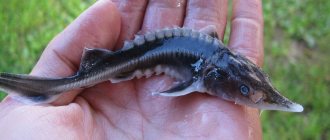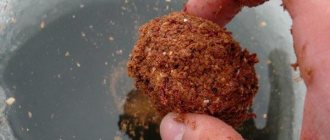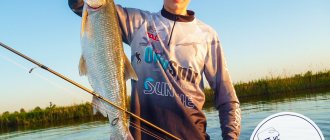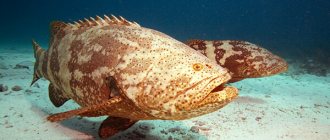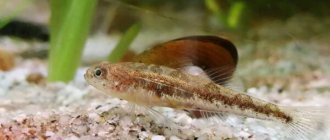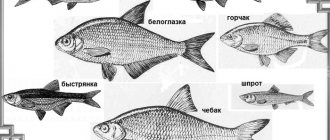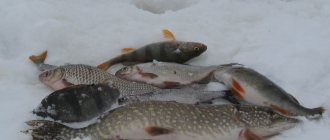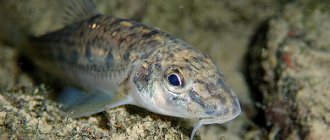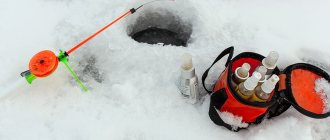Origin of carp
Today, many believe that carp is not a species of fish created by nature, despite the fact that it lives in reservoirs with stagnant water, as well as in reservoirs with weak currents. According to them, carp is the result of hard, many years of work by breeders who managed to domesticate the wild river carp, which at one time lived in southern China and the Caspian Sea. In fact, this approach is a serious misconception, since wild carp has always been distinguished by both river and lake forms. The varieties are based on the shape of the body. The shape of the carp, which inhabits bodies of water with fast currents, is distinguished by its torpedo-shaped shape, elongated in length. The same forms that live in reservoirs with stagnant water, where there is a lot of food and few predators, quickly grow upward, gaining weight.
It was this variety of carp, which easily survived the lack of oxygen, that was introduced by humans, without any selection efforts, into many reservoirs of many continents. Only at the stage of the last 150-200 years, when the issue of biological improvements of species came on the agenda, some original breeds and hybrids obtained under artificial conditions appeared.
A fish name such as “carp” has no connection with the scientific world, since it was formed absolutely by accident in the 19th century. This happened when the writer Sergei Aksakov mentioned this name in his works. He visited his homeland quite often, where he went to various bodies of water and fished. On the Belaya River (Agidel) he caught wild carp. Local fishermen called them “sazans”, which translated meant “silt fish”. This word is easy to remember, and it quickly captured the minds of many anglers. Speaking from a scientific point of view, wild and domestic carp are one and the same.
The lake form of carp is considered the basic one, as it is the most common and is of commercial interest. It is called the common carp, although other names may be applied to it, such as typical, golden or scaly. Often in everyday life, carp is called korop, which corresponds to the Old Slavonic name. Based on this, it is not difficult to imagine that our ancestors knew about this fish for a long time.
Naked (leatherback) carp
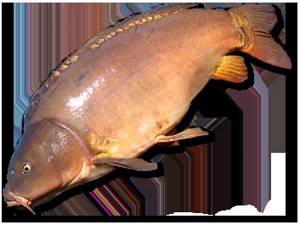
If you look closely at the picture of a naked carp, you will see a number of scales. Naked carp may have a certain number of scales, but the fundamental difference is either the complete absence of the dorsal row of scales, or its discontinuity. And from the head to the beginning of the dorsal fin there are no scales.
The growth rate of naked carp compared to scaly and mirror carp is much lower, which is determined by a much smaller number of blood cells. And accordingly, this means that this species needs water with a high oxygen content.
Naked carp are not as strong as their fellow species, they have fewer dorsal vertebrae and may differ in deformation of their fins.
Article on the topic: Fishing for carp and crucian carp
Features of appearance and its dimensions
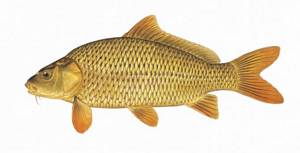
Common carp can be easily identified by a number of characteristic features. For example:
- The fish has a thick, tall and slightly elongated body.
- The body is covered with large, tightly fitting cycloid scales with a dark edge.
- The sides are distinguished by a golden or yellow-brown hue.
- The belly is wide, light in color.
- The mouth is large, which can extend into a tube.
- On the upper lip there are 2 pairs of sensitive but small whiskers.
- The eyes are high-set, with small pupils and golden-green irises.
- The back has darker shades. There is also a long dorsal fin of a gray-olive hue with a characteristic but shallow notch.
- The nostril openings are double.
Among other things, the carp’s body is covered with a layer of mucus, which reduces resistance to water movement, improves thermoregulation processes and protects the body from all kinds of parasites and infections.
At the same time, the fish can grow to impressive sizes, gaining considerable weight. There is official data that specimens were caught that were more than one and a half meters long and weighed about 55 kg. The average statistical size of individuals present in fishermen's catches weighs no more than 5 kg. Carp is considered a long-liver, as it can live more than 50 years. There are decorative varieties for which we will cross the 100-year mark.
Interesting fact! In the land of the rising sun, a 70-year-old Japanese man inherited a carp that lived in a pond and was 35 years older than him. The Japanese treated fish as a member of their family. He was offered several times to sell the carp for 20 thousand dollars, but the Japanese flatly refused.
Natural habitats
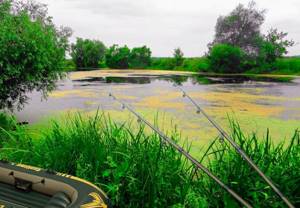
Carp is found on many continents, within temperate and southern latitudes. Prefers to live in reservoirs with weak currents, as well as in reservoirs with standing water. His favorite places are lakes with weak currents, ponds, quarries, canals and reservoirs, in which a soft clay or sandy bottom predominates, with an abundance of aquatic vegetation. Lives in water areas with a depth of 2 to 10 meters. This fish prefers to be in areas where there are shelters of any origin, so carp is rarely found in open areas where a flat bottom prevails. Its favorite areas are tree debris, submerged bushes, significant bottom unevenness, and thickets of aquatic vegetation.
This is carp!!! I want to go fishing there!!!
Carp diet
This fish is omnivorous, and also feeds almost constantly, eating shoots of aquatic plants, mollusks, eggs of fish and frog insects, and leeches.
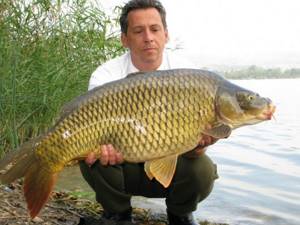
After winter, carp's diet is dominated by plants, and by autumn it completely switches to animal food.
What does carp eat?
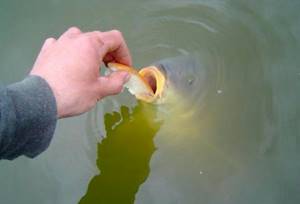
Carp is considered an unpretentious and fairly omnivorous fish. Since the carp's mouth has a special design, the fish easily filters the bottom soil, releasing nutritional components. Thanks to this mouth design, the fish mainly feeds from the bottom. That is why the bottom method of carp fishing predominates. The pharyngeal teeth of carp are quite sharp, and the dense and wide lips are adapted for grinding fairly hard food objects. The basis of the carp diet includes:
- Larvae, worms, small crustaceans.
- Insects, molluscs and tadpoles.
- Caviar of other fish species.
- Aquatic vegetation, vegetables and cereals.
- Leeches and detritus.
The favorite foods of carp are molting crayfish and pearl barley. In places where carp live, you can hear a characteristic crunch, which indicates that the fish is crushing shells. This often misleads inexperienced fishermen. Large specimens can swallow a gaping fry, but carps do not specifically hunt them. This fish has excellent hearing, which allows it to hear a bloodworm swarming in the ground or an insect falling into the water from a distance of tens of meters.
How to catch carp
A special series of rods has been created for catching fish of the carp family. They are called carp rods and take into account the behavioral characteristics of the fish. The durable material can withstand the jerks of even large fish, and the length of the fishing rod makes it possible to cast bait over a long distance.
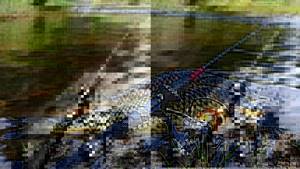
The line should be inconspicuous, but at the same time withstand the sharp jerks of the carp. The best option would be monofilament, the diameter of which is 0.2-0.3 mm. Since the water in reservoirs is cloudy, it is better to use green or brown fishing line.
A number of requirements are put forward for the reel - it must be durable, strong and powerful. Luck in the process of fishing for fish depends on the quality of the reel. It is also recommended to have a baitrunner on the reel. The baitrunner is an element of the reel that controls the tension of the fishing line. When the latch is open, the line unwinds freely, so that when a carp bites, the rod will not be dragged into the water. The closed latch allows you to hook fish and quickly reel in the line.
Another useful piece of equipment when fishing for carp is a signaling device. A special stand with a signaling device allows you to know about this when the fishing line is tensioned using a special signal. In the case when the fish pulls not from the shore, but towards it, then using a bitrate would be a good option. It is hung on a fishing line between the alarm and the reel, and when the tension is released, it transmits a signal to the alarm.
Since carp are very careful in the process of eating bait, the optimal solution would be to use rod-pods. These are professional stands for fishing rods, on which stabilizers can be installed. Typically, 3-6 fishing rods can be installed on a rod-pod at the same time.
There are also a number of requirements for hooks:
- High strength.
- A sharp sting.
- Resistance to extension.
Be sure to use an attachment on top of the hooks that would completely hide it. The most popular hooks among experienced fishermen are numbers 6-10 with a shortened tip.
When fishing from a boat, you can use bottom gear. Fishing this way is quite effective and efficient. If there is clean sand at the bottom, the catch from the boat often exceeds the amount of fish caught from the shore.
Lure
Traditionally, when fishing for carp, bait made from a mixture of flour, corn and pea grains is used. In spring and autumn, maggots, worms, and larvae of various beetles can be added to the bait. Complementary feeding from mixed feed or store-bought formula is also often used.
Carp bait

Since carp is omnivorous, it can be caught using a variety of baits. Experienced anglers use:
- Makuhu.
- Boiled or canned peas.
- Pearl barley balls.
- Crumb.
- Boiled potato pieces.
- Boiled or canned corn.
- Maggots.
- Worms.
- Shrimps.
- Dragonfly larvae.
- Boilies.
Boilies are balls containing soy flour, semolina, corn and eggs. They can often be bought ready-made in fishing stores.
When choosing bait, it is important to take into account the seasonal preferences of the carp and the characteristics of its habitat.
When can you catch carp?
Fish is caught by experienced fishermen throughout the year, but the optimal period is spring and summer. It is also important to take into account the characteristics of the place where fishing is expected. When the water warms up to 15-18 degrees, the fishing season can open. Since carp loses a lot of strength during the winter, about a week after spawning it strives to restore what it has lost and attacks any food with a special appetite.
Carp like to eat at any time of the day, so it doesn’t matter to them when they take the bait. Often, with changes in weather and temperature, the bite can deteriorate greatly or stop completely. Carp does not like extreme heat, wind and prolonged rain. The fish begins to be active in cloudy weather and days with light wind.
Best biting period
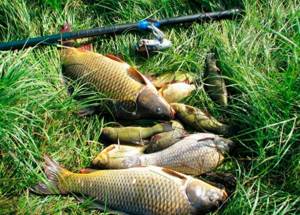
Carp are caught from May, when the water warms up to 10 degrees, until autumn (until September, sometimes until October).
Factors favorable for fishing: muddy water with a moderately rising level, warm, stuffy cloudy weather, weak southwest or southeast wind with decreasing atmospheric pressure (especially early in the morning and evening - before sunrise and after sunset), as well as 12 - 24 hours before the weather changes for the better.
CARP on FLOAT | Fishing in the reeds
Lifestyle Features
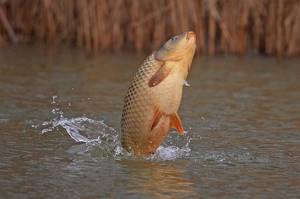
After birth, carp fry gather in numerous schools, but as they grow older, these schools break up into smaller ones, which is associated with changes in the fish’s diet. Eventually, trophy individuals begin to lead a separate way of life. The highest degree of carp activity occurs during the warm period, from April to October.
The first peak of active feeding of carp occurs in June, when the fish, hungry after spawning, begin feeding around the clock. With the arrival of the summer heat, it is better to catch carp early in the morning or late in the evening. If the weather is rainy and cloudy outside, the carp feeds throughout the day, both day and night.
The second peak of active feeding begins in August and continues until the end of October. This is due to the arrival of cold weather and the carp begins to actively stock up on nutrients for the winter. During this period, he actively hunts and takes any bait. Therefore, at this time, carp often becomes part of the catch of amateur fishermen. Carp overwinter in wintering pits, where there is a weak current, together with other representatives of their family. During this period, the carp practically does not feed until spring, being in a state of suspended animation.
Carp spawning
Carps reach sexual maturity quite late. Males are able to reproduce in the third year of their life, and females only by the age of five.
Carp spawning occurs late, in late May - early June. This is due to the fact that the water must warm up to a temperature of +18°C. If the spring turns out to be cool, then carp can spawn in mid-June.
For spawning, the female chooses shallow water, where the depth is no more than half a meter. During carp spawning, you can even notice the dorsal fins of large specimens scurrying around in shallow water.
Before spawning, the female acquires several “gentlemen” who accompany her everywhere. The spawning area should be overgrown with thick algae or grass, into which the carp eggs will be deposited. Spawning occurs over several days. Females lay eggs from sunset until the morning.
Reproduction

Carp spawns quite late, when the water begins to warm up to at least +18 degrees. As a rule, this is the end of May or the beginning of June, which indicates that this fish is thermophilic. Individuals become sexually mature at the age of 3 to 5 years. When females are ready to spawn, they are accompanied by several males of the same age. They go to shallow water, up to half a meter deep, overgrown with aquatic vegetation. Egg throwing takes place over 2-4 days, with the eggs being deposited in separate portions. In general, a female, depending on her age, is capable of laying from 0.2 to 1 million eggs. After a maximum of 6 days, fish fry emerge from the eggs. After birth, they continue to feed on nutrients stored in the yolk sac for some time. As soon as the fry gets stronger, it goes into free swimming and begins to feed on zooplankton.
General characteristics
Crucian carp, carp and carp are representatives of a large family of carps and the order Cyprinidae, which differ in their different body structure, habits and way of life. However, the structure of the internal organs of each species remains identical: fish do not have a stomach, but they have a Weberian apparatus, which increases hearing abilities. Due to the characteristic shape of the head, the fish calmly takes food directly from the bottom.
Common in lakes and private ponds, carp is a domesticated variety of carp, which was bred for industrial use and sport fishing. And although the real species is not much different from the cultivated one, some differences are still present. For example, for carp:
- Darker scales that cover the entire body.
- Larger head.
- Elongated body.
Through constant crossbreeding of carp and carp, breeders are able to develop new carp breeds that demonstrate unique traits, including winter hardiness, rapid weight gain in a short period, and excellent fertility.
As for crucian carp and crucian carp, these species are also very similar to each other. However, the first one:
- The antennae are missing.
- Higher back.
- Compressed and inflexible body.
- Hard, light scales.
- Smooth contour of the fin on the back.
Under natural conditions, species often interbreed, resulting in the formation of a unique hybrid called crucian carp or crucian carp.
It is important to note that sea carp also exists in nature, although it differs significantly from its freshwater relatives. And sea crucian carp does not belong to the carp family at all.
As for domesticated species, they may have different types of scales. For this reason, a special classification was created, which included the following varieties of carp:
- Mirror.
- Scaly (common).
- Naked.
- Framed.
Depending on the place of residence, there are river and pond species.
Types of carp with photos
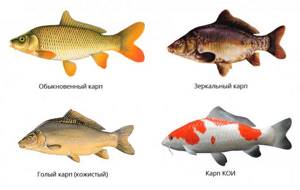
In addition to the common carp, which is considered the most hardy representative of this large family, other cultivated species bred artificially are also found in fish farms, lakes and reservoirs.
Mirror carp
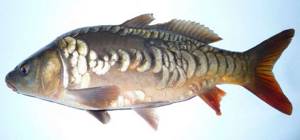
This type of carp is considered the result of successful breeding work aimed at increasing the fertility and weight of the fish. The mirror carp first appeared in Germany at the beginning of the 19th century under the same name. This type of carp differs from the original species in the presence of larger fins with fewer bony rays, as well as faster weight gain and the shape of the scales on the body. As a rule, mirror carp scales cover only part of the body, in the form of rounded mirrors. Depending on the location of the scales on the body of the fish, there are several types of mirror carp - framed, scattered and linear. Due to the fact that mirror carps have a strict attachment to the food base, consisting of shellfish and cereals, this factor significantly simplifies the process of keeping fish in artificial reservoirs.
naked carp
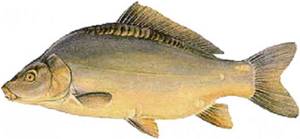
Naked carp appeared as a result of further work by breeders on mirror carp. The main difference between the species is the complete absence of protective cover in the form of scales. It has another name - leather carp. In this case, a minimum number of large scales is allowed in the back area, as well as at the base of the caudal fin.
Interesting to know! Naked carp have a rather weak immune system and are susceptible to infection by various parasites. Due to this fact, the species is not of great economic importance, but is bred for recreational and sport fishing.
Carp
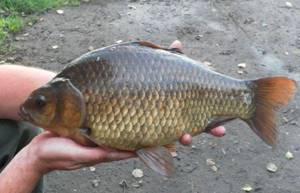
As a result of severe food competition between the two species, it was necessary to control the number of super-prolific crucian carp in order to prevent the predominance of small numbers.
Having set this goal, in the 1980s a special breed was bred in Russia - carp, which was distinguished by unique characteristics: rapid weight gain, high nutritional value and inability to reproduce. In addition, the hybrid has other features: the head and color correspond to crucian carp, and the body corresponds to carp. Thanks to its unique characteristics, in just a couple of years of life, the fish gains weight of almost 2 kg.
Koi carp
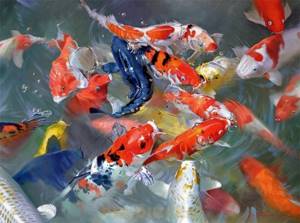
Back in the 1st and 2nd centuries, the Chinese were engaged in crossing closely related generic taxa. As a result, it was possible to obtain unique offspring from wild carp and local crucian carp. This offspring is still known to all aquarists, as they called the decorative species “goldfish”. This hybrid represents the body of a carp and has retained the ability to reproduce independently. Moreover, its body color is either white or red. Further crossbreeding work resulted in pink and spotted varieties.
Interesting fact! This fish, bred in China, quickly found its way to Japan, where it became widespread among rice farmers far from easily accessible areas. Weather conditions cut people off from civilization for a long time, leading them to protein starvation. And then this problem was solved thanks to this unpretentious fish, which was kept in special water tanks intended for watering rice fields.
The word "koi" means "carp" in Japanese and is used to describe this unique taxon, which is capable of growing up to 1 meter in length. The Japanese also use another term “nishikigoi”, which means “brocade carp”. At least 80 breeds of this carp have been bred, and mirror carp also took part in this. These species are now kept in homestead or carp ponds in various parts of Japan. As a rule, this is done for the purpose of cultural and aesthetic pleasure.
Siamese carp
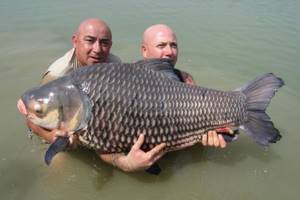
The Siamese carp, also called the giant barbel, is considered the most numerous representative of this family. This fish prefers to lead a peaceful way of life, feeding mainly on phytoplankton, algae, plants, cereals and fruits. Despite this “diet”, some individuals grow to impressive sizes, gaining weight of about 50 kg, or even more. There is evidence that fishermen have come across specimens weighing up to 300 kg and up to 3 meters long.
Mirror carp
Mirror carp
The mirror carp is the first mutation of the common carp created by man. The appearance of this carp is associated with two alternative forms of genes, influencing a very wide range of traits. Mirror carp has fewer rays on all fins compared to common carp or common carp.
Mirror carp, like all other species, has a set of genes responsible for growth, scale color, etc., this has led to considerable confusion in defining the concept of breed and species. It is also known that it is the mirror carp that gains the most weight in comparison with the scaly, naked and linear species. All for the same genetic reasons.
Article on the topic: Wobblers for fishing photo
Nutritional value of carp
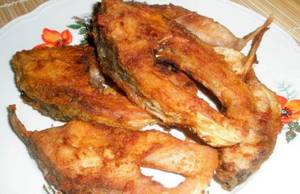
Despite the fact that carp meat is quite bony, it is also quite tasty. In addition, it contains polyunsaturated fatty acids Omega-3 and Omega-6. There are only 115 kcal per 100 grams of meat, which makes it indispensable for dietary nutrition. If you fry fish, its energy value increases by 2 times, which those who watch their figure should know about. For those who want to get rid of extra pounds, it is better to eat boiled fish, stewed or baked in the oven. The meat of this fish contains all the necessary nutrients that are so necessary for the normal functioning of the human body.
Regular consumption of fish dishes helps strengthen bone tissue, normalize mental activity and the functions of the cardiovascular system. At the same time, the aging process slows down and the immune system is strengthened.
What can you cook from carp?
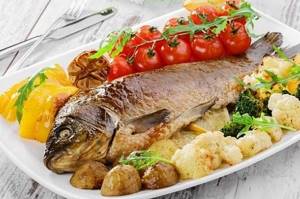
Fish soup is most often prepared from carp, baked whole or in portions, fried, made into aspic and grilled. Among the large number of recipes, it is difficult to choose the most delicious ones. Carp fillets are often used to prepare delicious smoked balyks. Since fish has low fat content, it is optimal for preparing dietary soups and other dishes.
Carp soup
A photo of a carp fish allows you to fully appreciate the amount of meat that is on the ridge. To prepare the first course you will need one small fish, weighing no more than 500 grams, 4-5 medium potatoes, carrots, onions, a small celery root, sunflower oil, white peppercorns, bay leaf, salt, ground black pepper, herbs (dill, parsley , green onions).
First you need to gut the carp and clean it of bones. The fillet is cut into portions. The gills need to be pulled out of the heads. The tail and head will be needed for cooking the broth. Part of the tail and the cleaned head are poured with one and a half liters of water and cooked for 45 minutes over low heat. When the broth boils, you need to add bay leaf and pepper. When the broth is cooked, it must be strained.
Potatoes must be peeled and cut into cubes. Carrots, celery and onions are finely chopped and fried in a frying pan. Potatoes and chopped fillet are added to the strained broth, after which the pan must be put on fire and the soup must be salted. 15 minutes after boiling, the fried mixture is added to the soup. After the frying has been added, the soup must still be cooked for 7-10 minutes. At the end, chopped herbs and ground pepper are added to the dish.
